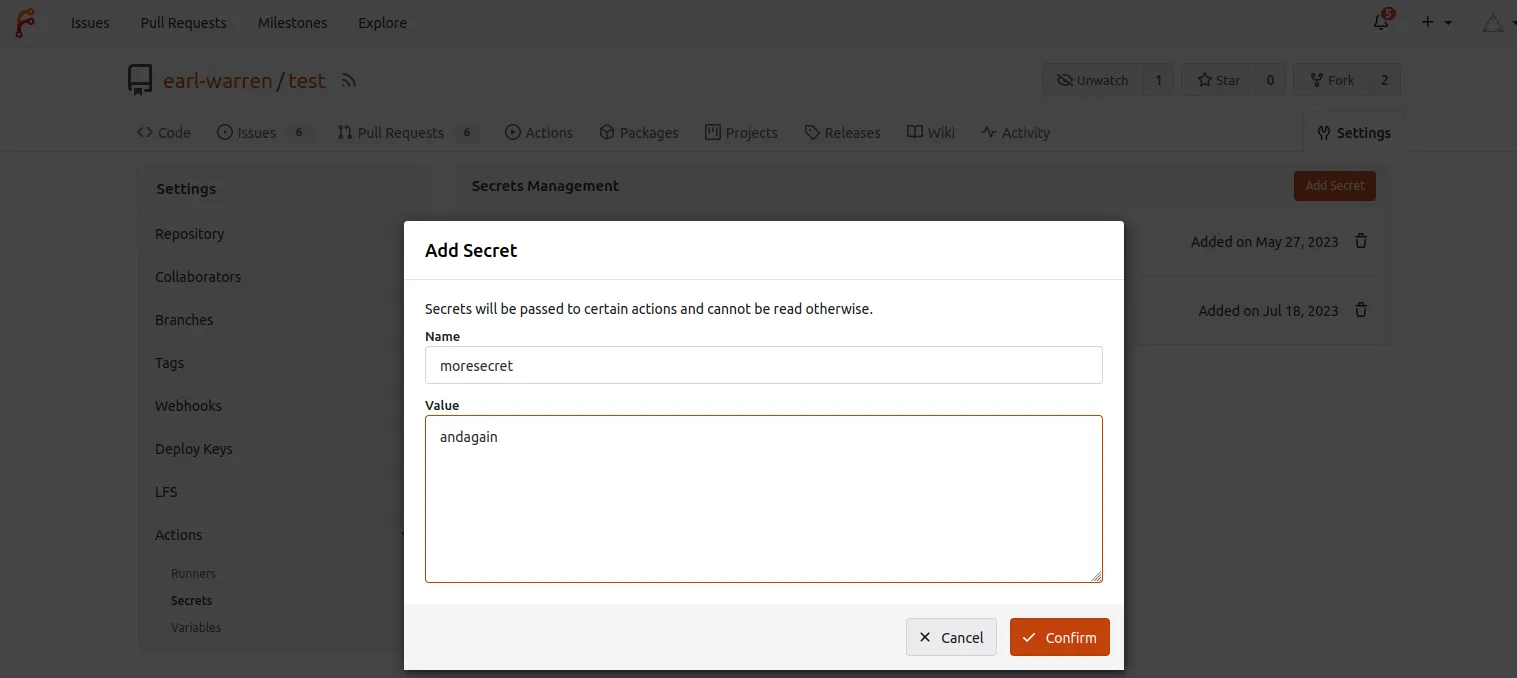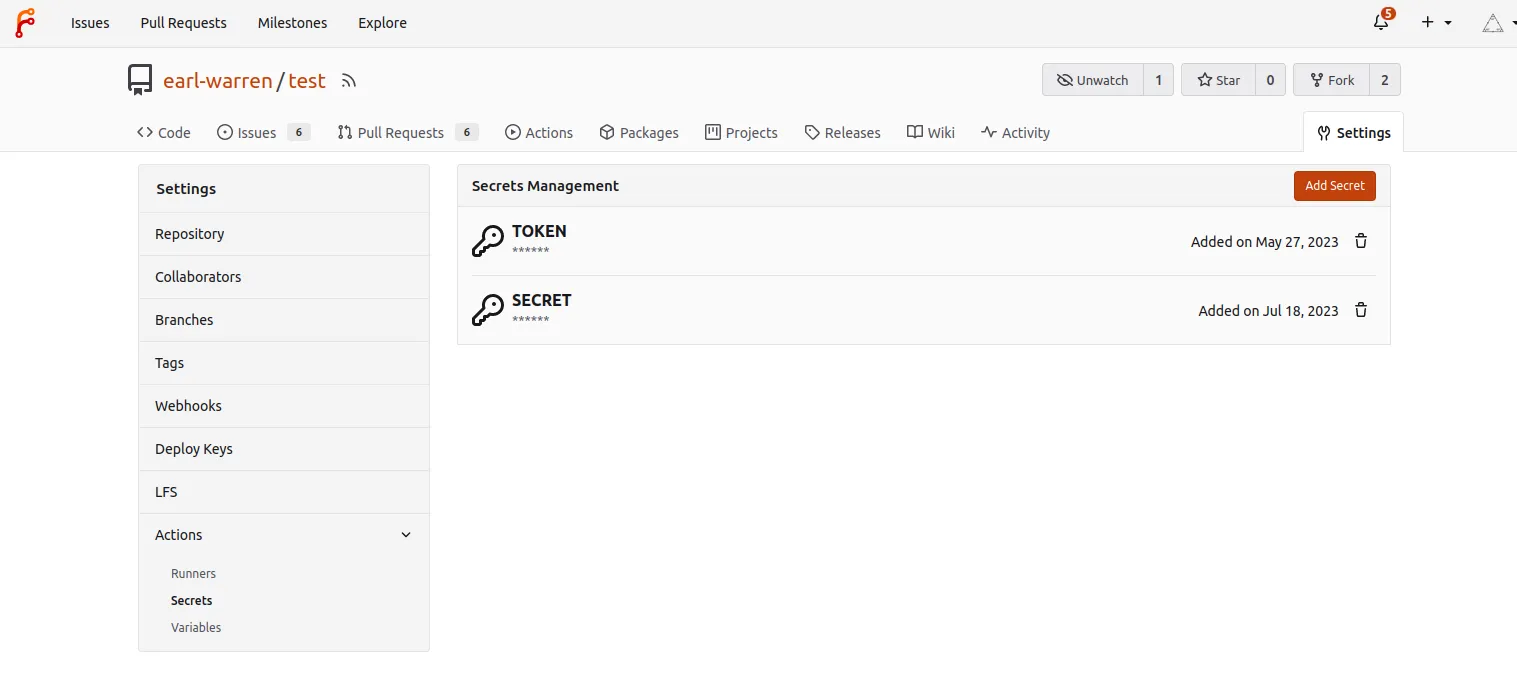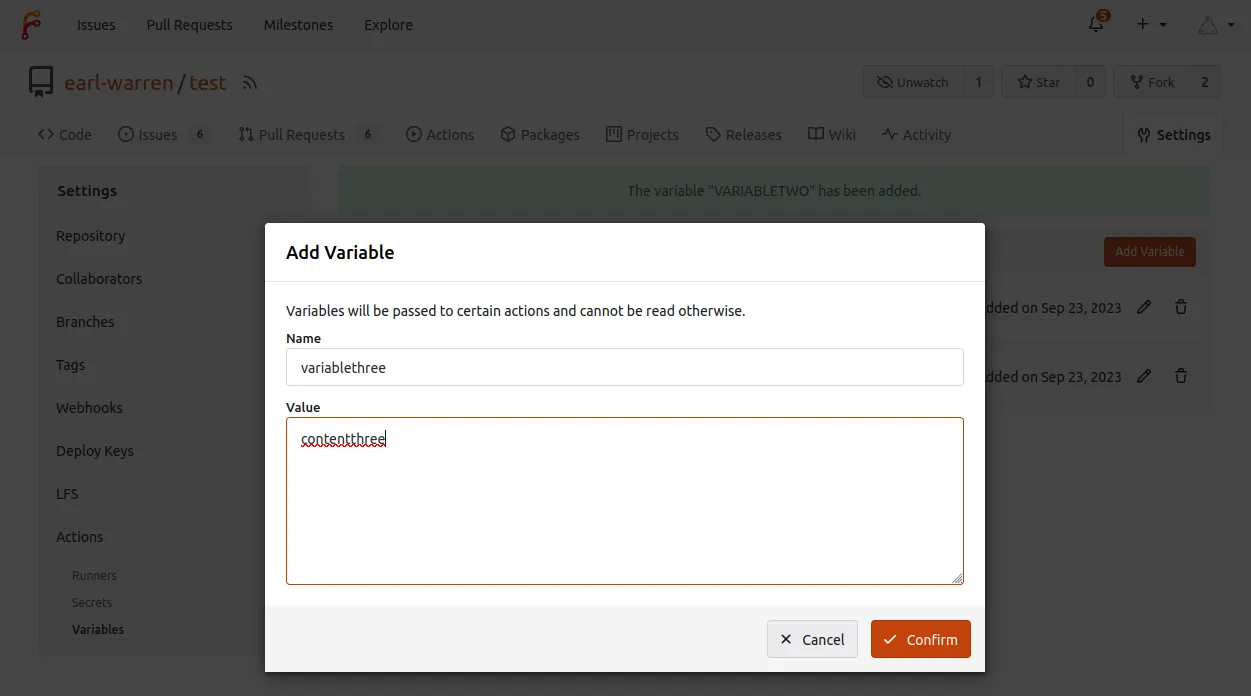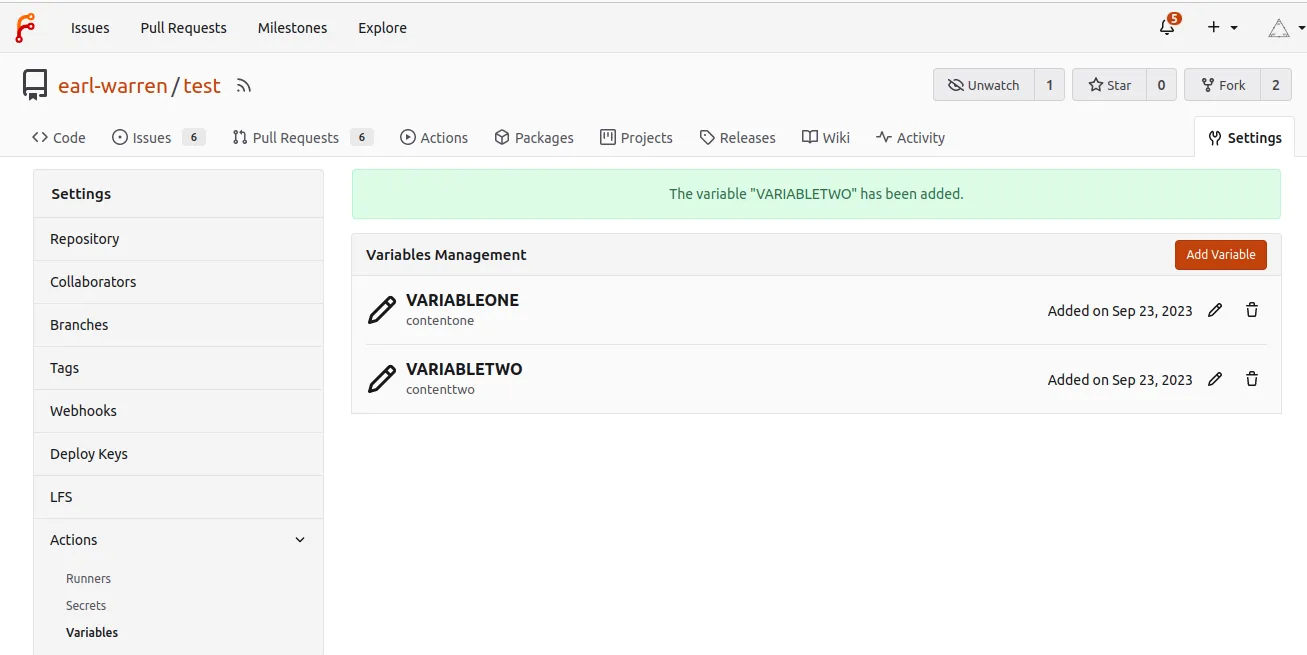Forgejo Actions | Basic concepts
This page explains the basic concepts you’ll encounter when using Forgejo Actions.
All Forgejo Actions workflows are defined in workflow files. These are .yaml files stored in the .forgejo/workflows directory of a repository. Below is an example of a simple workflow file:
Basic syntax
on: [push]
jobs:
print-content:
runs-on: docker
steps:
- name: checkout code
uses: actions/checkout@v4
- name: list directory contents
run: ls -laThe on key specifies which events the workflow should trigger on. In this case it triggers on any push operation. You can narrow this down to specific branches, or trigger on other events like issues or pull requests.
The jobs key contains the jobs that are part of this workflow. A job is one unit of work that will be handed out to a runner. A workflow may contain multiple jobs. By default, these will run independently from one another.
This workflow contains one job, called print-content. The runs-on key specifies the label of the runner the workflow will run on. This job will only run on runners with the docker label.
A job consists of one or more steps. The steps are executed in order. If one step fails, the job will clean up and no further steps will be run.
The first step, checkout code, uses an action to check out the contents of the repository into the working directory. Actions are reusable procedures for doing something in your CI workflow. Read more about actions.
The second step, list directory contents, runs the provided command in the shell of the job. In this case it lists the contents of the working directory.
That concludes the basic syntax of a workflow file. For a complete definition of the syntax of a workflow file, see the workflow reference.
Expressions
In a workflow file you may use expressions. These look like ${{ ... }}. Expressions are evaluated by the runner when executing a workflow. In certain fields of the workflow file, like if: , the ${{ }} is implicit and can be stripped.
NOTE: Implicit type conversions with booleans may be difficult to figure out when assigned to actions inputs or output values. It is easier for debugging to use explicit strings (e.g. ‘yes’ or ‘no’) instead of true/false or ‘true’/‘false’.
Check out the expression example
Variables
You can use variables to read information from the workflow context. There are many different variables available. For example, the expression ${{ forgejo.ref_name }} would be substituted with the name of the branch the workflow is running for.
For a complete list of the values available in the workflow context, see the workflow reference.
Literals
You may use the following types of literals in expressions:
- boolean: true or false
- null: null
- number: any number format supported by JSON
- string: enclosed in single quotes
Logical operators
You may use the following logical operators in expressions:
| Operator | Description |
|---|---|
( ) | Logical grouping |
[ ] | Index |
. | Property de-reference |
! | Not |
< | Less than |
<= | Less than or equal |
> | Greater than |
>= | Greater than or equal |
== | Equal |
!= | Not equal |
&& | And |
|| | Or |
NOTE: String comparisons are case insensitive.
Conditionals
You may use these functions in if: conditionals on jobs and steps.
success(). returns true when none of the previous jobs/steps have failed or been cancelled.always(). causes the job/step to always execute, and returns true, even when cancelled. If you want to run a job/step regardless of its success or failure, use the recommended alternative:'!cancelled()'(the expression must be enclosed by quotes to not be interpreted as YAML tag).failure(). returns true when any previous step/job has failed.
Functions
You may use these functions in expressions:
contains( search, item ). Returnstrueifsearchcontainsitem. Ifsearchis an array, this function returnstrueif theitemis an element in the array. Ifsearchis a string, this function returnstrueif theitemis a substring ofsearch. This function is not case sensitive. Casts values to a string when comparing.startsWith( searchString, searchValue ). ReturnstruewhensearchStringstarts withsearchValue. This function is not case sensitive. Casts values to a string.endsWith( searchString, searchValue ). ReturnstrueifsearchStringends withsearchValue. This function is not case sensitive. Casts values to a string.format( string, replaceValue0, replaceValue1, ..., replaceValueN). Replaces values in thestring, with the variablereplaceValueN. Variables in thestringare specified using the{N}syntax, whereNis an integer. You must specify at least onereplaceValueandstring. Escape curly braces using double braces.join( array, optionalSeparator ). The value forarraycan be an array or a string. All values inarrayare concatenated into a string. If you provideoptionalSeparator, it is inserted between the concatenated values. Otherwise, the default separator,is used. Casts values to a string.toJSON(value). Returns a pretty-print JSON representation ofvalue.fromJSON(value). Returns a JSON object or JSON data type forvalue. You can use this function to provide a JSON object as an evaluated expression or to convert environment variables from a string.hashFiles(pattern[, ...]). Returns a hash (e.g.39b35c59b92fdb3024d09a4f2f960d123ba59c3d531569f5195b65fbf0a40161) based on the concatenated content of all the files matching the patterns given in argument. Returns an empty string if the files are not found. It is a JavaScript function executed in the container running the action and requires Node.js to be installed.
Some of these functions cast values to strings in order to compare them. The following conversions are used:
| Input type | Output result |
|---|---|
null | '' (empty string) |
| booleans | 'true' or 'false' |
| numbers | decimal format, exponential for large numbers |
| arrays | arrays are never converted to strings |
| objects | objects are never converted to strings |
Secrets
A repository, a user or an organization can hold secrets, a set of key/value pairs that are stored encrypted in the Forgejo database and revealed to the workflows as ${{ secrets.KEY }}. They can be defined from the web interface:
- in
/org/{org}/settings/actions/secretsto be available in all the repositories that belong to the organization - in
/user/settings/actions/secretsto be available in all the repositories that belong to the logged in user - in
/{owner}/{repo}/settings/actions/secretsto be available to theworkflowsof a single repository

Once the secret is added, its value cannot be changed or displayed.

Custom variables
A repository, a user or an organization can hold variables, a set of key/value pairs that are stored in the Forgejo database and available to the workflows as ${{ vars.KEY }}. They can be defined from the web interface:
- in
/org/{org}/settings/actions/variablesto be available in all the repositories that belong to the organization - in
/user/settings/actions/variablesto be available in all the repositories that belong to the logged in user - in
/{owner}/{repo}/settings/actions/variablesto be available to theworkflowsof a single repository

After a variable is added, its value can be modified.

Name constraints
The following rules apply to variable names:
- Variable names can only contain alphanumeric characters (
[a-z],[A-Z],[0-9]) or underscores (_). Spaces are not allowed. - Variable names must not start with the
FORGEJO_,GITHUB_orGITEA_prefix. - Variable names must not start with a number.
- Variable names are case-insensitive.
- Variable names must be unique at the level they are created at.
- Variable names must not be
CI.
Precedence
A variable found in the settings of the owner of a repository (organization or user) has precedence over the same variable found in a repository.
Automatic token
At the start of each workflow, a unique authentication token is automatically created and destroyed when it completes. It can be used to read the repositories associated with the workflow, even when they are private. It is available:
- in the environment of each step as
FORGEJO_TOKEN - as
forgejo.token - as
env.FORGEJO_TOKEN - as
secrets.FORGEJO_TOKEN
To help with reusing actions and workflows originally developed for GitHub Actions, they are also available under the following names:
GITHUB_TOKEN==FORGEJO_TOKENgithub.token==forgejo.tokenenv.GITHUB_TOKEN==env.FORGEJO_TOKENsecrets.GITHUB_TOKEN==secrets.FORGEJO_TOKEN
This token can only be used for interactions with the repository of the project and any attempt to use it on other repositories, even for creating an issue, will return a 404 error.
This token also has write permission to the repository and can be used to push commits or use API endpoints such as creating a label or merge a pull request.
In order to avoid infinite recursion, no workflow will be triggered as a side effect of a change authored with this token. For instance, if a branch is pushed to the repository and there exists a workflow that is triggered on push events, it will not fire.
A workflow triggered by a pull_request or pull_request_target event from a forked repository is an exception: in that case the token does not have write permissions to the repository. The pull request could contain an untested or malicious workflow.
NOTE: In the case of a
pull_request_targetthe risk is mitigated and the automatic token may be given write permissions in future versions of Forgejo.
Actions
An action is a reusable procedure for accomplishing something in your CI workflow.
Using actions
To use an action, specify the uses: key in a step like this:
- name: Checkout the repository
uses: actions/checkout@v4
with:
ref: 'main'The uses key contains the name of the repository the action is stored in. You can specify it in shorthand like above, in which case it will be prefixed with the DEFAULT_ACTIONS_URL. You can also specify the full url: uses: https://codeberg.org/username/yourcustomaction.
The with key contains parameters to be passed to the action. Which parameters are available depends on which action you are using. You can find in the documentation of the action you are using.
Creating actions
An action is a repository that contains the equivalent of a function in any programming language. It comes in two flavors, depending on the file found at the root of the repository:
- action.yml: describes the inputs and outputs of the action and the implementation. See this example.
- Dockerfile: if no
action.ymlfile is found, it is used to create an image withdocker buildand run a container from it to carry out the action. See this example and the workflow that uses it. Note that files written outside of the workspace will be lost when the step using such an action terminates.
Just as any other program or function, an action has pre-requisites to successfully be installed and run. When looking at reusing an existing action, this is an important consideration. For instance setup-go depends on NodeJS during installation.
To read more about creating your own actions, see the actions guide.
